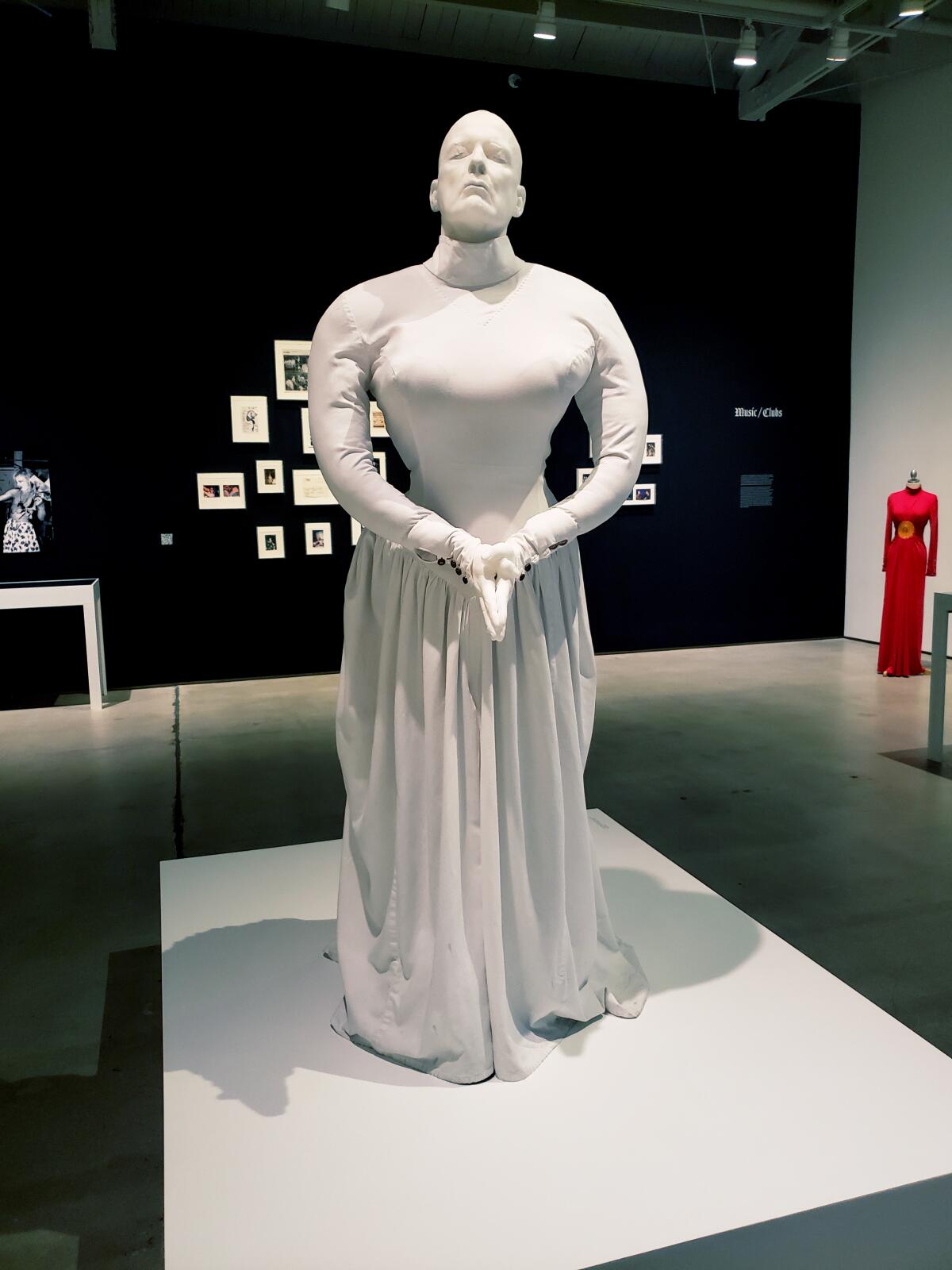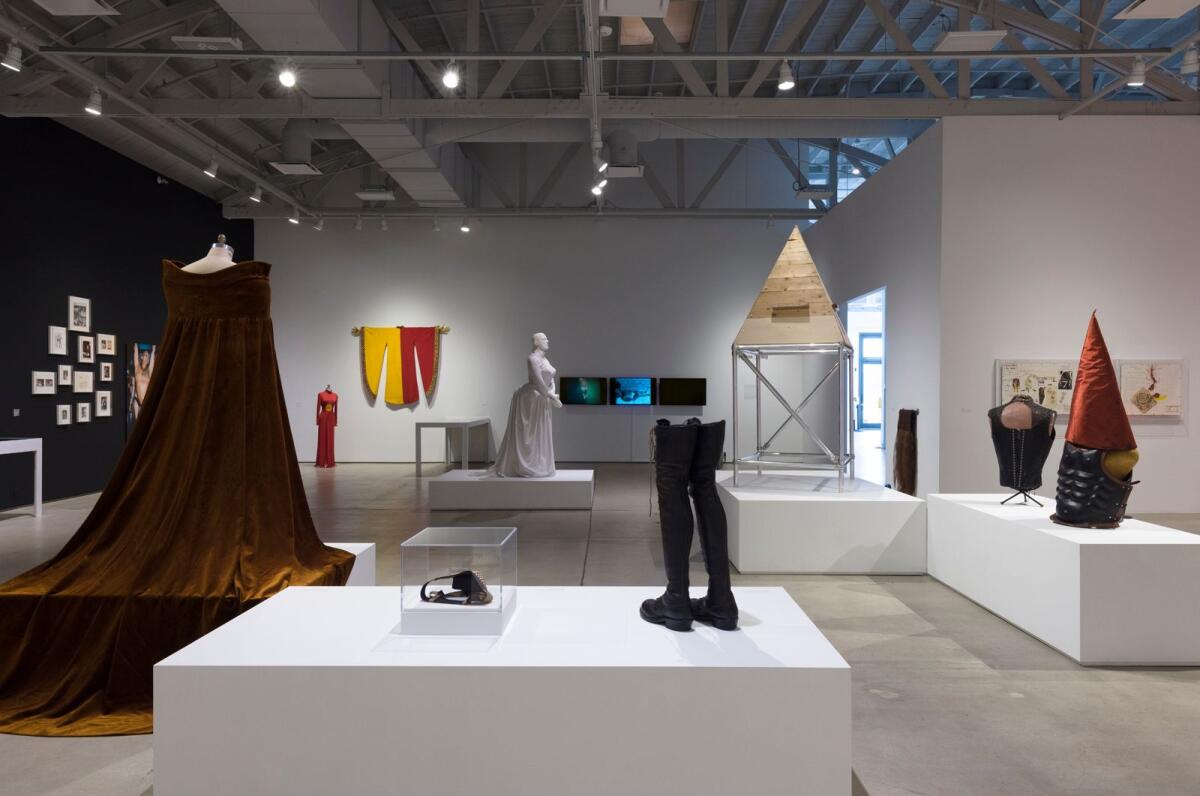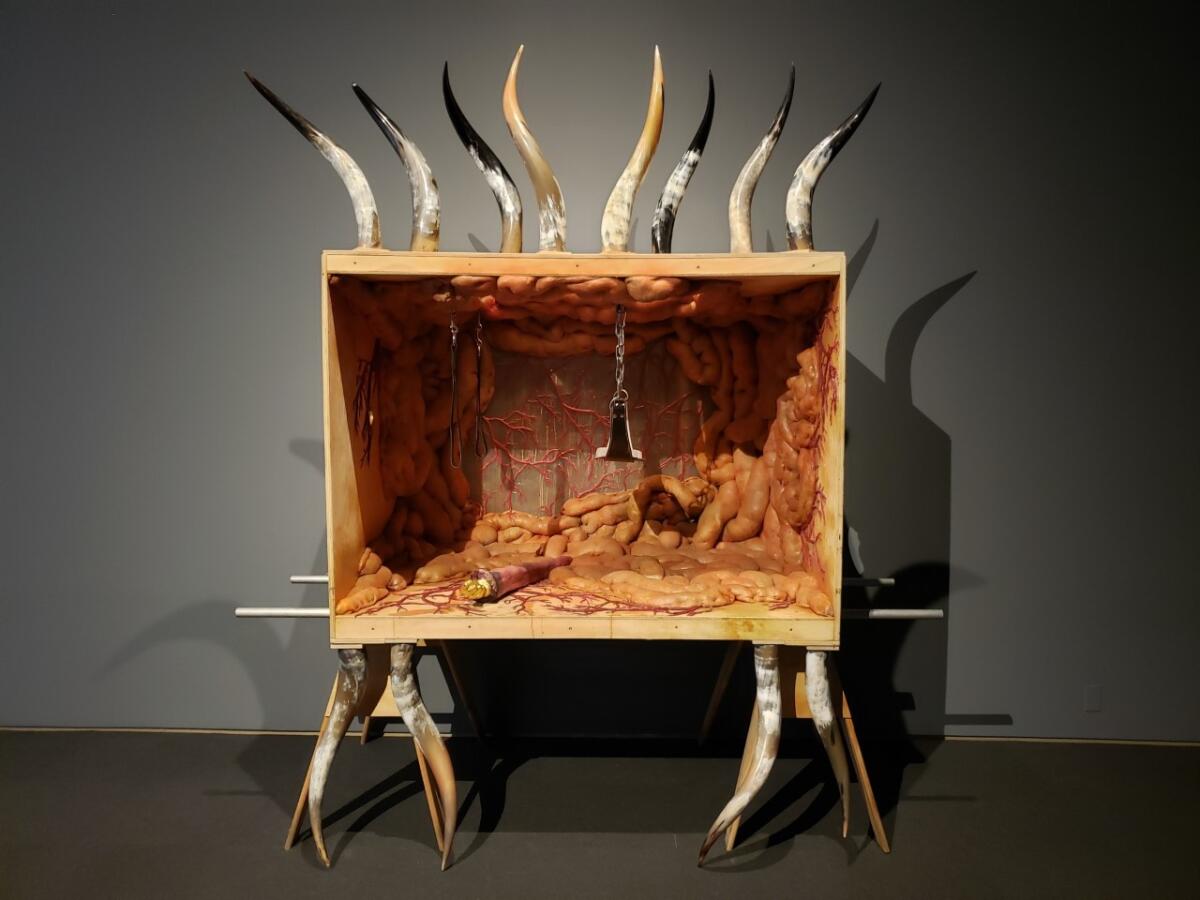Review: ‘Queer Communion’ and the engrossing, squirm-inducing world of Ron Athey

The word “queer” went mainstream about 20 years ago. Its hostile, “Lord of the Flies” connotation of social pariah was shed to become a self-affirming term adopted by sexual and gender minorities who are not heterosexual or cisgender.
That timeline makes “Queer Communion: Ron Athey,” the absorbing new 35-year survey exhibition of the well-known L.A. performance artist, no “Queer Eye for the Straight Guy.” Mainstream does not describe Athey’s art. From the first work to the last, beginning in the 1980s, emerging full force in the 1990s and continuing to the present, this show goes a long way toward illuminating the originally transgressive edge of being pro-queer.
At the Institute of Contemporary Art, Los Angeles, “Queer Communion” opens with performance documentation that includes video in which a shirtless young man wielding a large knife engages in ritual cutting of his own flesh. The visible scars that crisscross his body amid fresh new tracings of blood confirm that this is not the first time that self-harm has been undertaken.
Repetition is at the core of ritual.
The bladework is difficult to watch. For Athey’s art, that difficulty is a virtue, not a vice. Witnessing the inescapable physical materiality of the body and the blood in a ritual performance cannot help but summon the Christian sacrament of the Eucharist. That’s a subject with a long history in Western religious art, but here it is in a purely secular frame.
The scene, far from modeling aberrant behavior to be adopted by a viewer, creates squirming discomfort. You’re in an art space, after all, and you are meant only to look.

Doing so forces open an otherwise clenched acceptance of seemingly undemanding norms. One might think that sacramental bread and wine are merely metaphors, but the religion’s adherents believed from the earliest centuries in their miraculous transformation into actual body and blood to be ingested.
Athey, 59, was born into a fundamentalist Pentecostal family. His father having disappeared and his schizophrenic mother hospitalized, he was raised by a grandmother. Her enthusiasm for histrionic, healing revival meetings all over inland Southern California were the motive for regular family outings.
Being gay did not fit that hyperreligious program, except insofar as the artist embraced the faith’s extravagantly theatrical commitments. One fringe performance activity fed into another as he matured and began to embrace the new performance art genre.
Athey is self-taught as an artist. His elaborately costumed, frequently sadomasochistic performance work makes the typical flamboyant hucksterism of old faith healers like Kathryn Kuhlman or Oral Roberts look somber and dignified.
Lavishly tattooed before it was cool — he describes himself as “a marked man” — he’s an exhibitionist and provocateur. I ran into Athey many years ago in a Hollywood supermarket while squeezing cantaloupes and was startled — the first time I had seen face tattoos up close.
The swastika design inked at the base of his neck in the back originated from an ancient Indonesian spiritual symbol. While there can be little doubt that his interest in its sacred dimension is authentic, neither can there be a question that he knew full well the vile Nazi meanings the broken-cross shape long ago accrued. (When the rancid white nationalism that today infects America first began to rise, he had the tattoo covered over with black ink.) That stark push-pull, a simultaneous attraction and repulsion, is fundamental to his aesthetic.
Flirting, he once called it. With demons, I might add.
Painter Hans Hoffmann might have made the formal push-pull of color and shape the basis on which post-World War II abstract art in America was built. But after the collapse of both painting and abstraction from their establishment pedestals in the 1970s, the field of push-pull opened a gaping social dimension.
Carolee Schneemann had been a pioneer in the 1960s, orchestrating performances around sexuality, gender and the flesh. Athey is a second generation to artists like Paul McCarthy and the late Mike Kelley, both of whom did ritually oriented performance art in the 1970s and 1980s in addition to sculpture, video and installations.
Athey is atheist. But in his performance art, as in Pentecostalism, concrete experiential knowledge is favored over theoretical, abstract musing. A vitrine featuring posters, fliers, advertisements and other ephemera about the late “Dr. Miss Velma” Jaggers and the Universal World Church sets the stage.
In one photo, Jaggers, a platinum blonde at age 76 married to her preacher-cousin Orval, is decked out in a lemon yellow ballgown with an enormous hoopskirt of layered lace, a crimson silk rose pinned at the waist and bright-red ribbons streaming to the floor. She’s like an enormous Ginger Rogers party cake decorated with the bloody stigmata of a martyr.
Nearby, a tall and imposing mannequin whose shaved head is modeled on Athey is dressed in an austere white evening gown with a high neck, large bust, cinched waist and ample bustle. Gloved hands clasped in front of him, he’s like Regina Giddens gone bald from scabrous family dealings in “The Little Foxes.”
The dress is an old performance costume. In the show’s final room, where projected videos show recent performances, a big wooden box adorned with six pairs of steer horns is a recent model for a film’s stage set, its interior walls covered with viscera.
Gallery-bound exhibitions of performance art are not easy to pull off, but “Queer Communion” does a good job of it. (The survey, seen earlier this year at Participant Inc., an art and performance space in New York, was organized by USC art historian Amelia Jones.) Costumes, assorted props, plentiful ephemera and video clips are divided into five well-organized thematic chapters.

One deals with “Religion/Family,” another with “Music/Clubs.” Athey’s post-punk club roots merged with the trauma, physical and political, of the AIDS epidemic and its bodily and emotional degradations. (The artist has long been openly HIV-positive.) His performance work came into its own in the 1990s.
One of the most incisive themes is the mashup of art, performance and politics in that volatile decade, the messy aftermath of the awful Reagan era. Unabashedly extremist ultraconservatives like Jesse Helms, the fundamentalist white racist who represented North Carolina in the U.S. Senate for 30 years, and gleefully sexist former Rep. Robert Dornan from Orange County, who outed a fellow congressman as gay on the floor of the House, turn up like bad pennies.
They wielded considerable command over other people’s lives, unlike the artist.
Included is an archival C-SPAN video of Helms’ infamous 1994 performance at his Senate podium, where he attacked Athey over participation in a Minneapolis performance festival. The artist’s self-lacerating piece was funded to the tune of $150 from a National Endowment for the Arts grant, while the bigoted pol was pocketing more than $130,000 in taxpayer-funded annual salary.
As if to italicize the disproportion, the C-SPAN video monitor is installed near a vitrine with some performance artifacts — a regal crown and a bishop’s miter from the performance “Incorruptible Flesh,” both made from gold-painted cardboard gussied up with cheap plastic jewels.
Huntington Art Museum officials are overruling their own conservation experts’ advice by lending the fragile painting to Britain’s National Gallery.
Athey may have had an Indonesian temple swastika tattooed on his neck, but Helms had a Confederate flag tattooed on his heart. The Helms video is must-see TV — especially now, as conservative elected officials like Georgia Rep. Marjorie Taylor Greene and Arizona Rep. Paul Gosar froth at the mouth about fictitious enemies eating babies and compare vaccination identification to Nazi persecution of the Jews.
Control over one’s own body within a larger social matrix is a complicated leitmotif of the exhibition. But in a culture war, the casualties are civilian. Ordinary people living their lives get smacked around by people with ambition and power.
Ultraconservatives, despite their relatively modest numbers, gained exceptional authority with the rise of the religious right in the 1980s. They still carry outsized weight today, as evidenced by current efforts to turn Ashli Babbitt, a domestic terrorist killed during the Jan. 6 attack on the U.S. Capitol, into a righteous victim.
The show is timely. Juxtaposed with Athey, an extremist of an effectively harmless sort, narratives of bloody martyrdom as the path to salvation are thrown into high relief.
'Queer Communion: Ron Athey'
Where: ICA LA, 1717 E. 7th St.,
When: Through Sept. 5. Closed Mondays and Tuesdays.
Info: (213) 928-0833, www.theicala.org
More to Read
The biggest entertainment stories
Get our big stories about Hollywood, film, television, music, arts, culture and more right in your inbox as soon as they publish.
You may occasionally receive promotional content from the Los Angeles Times.







